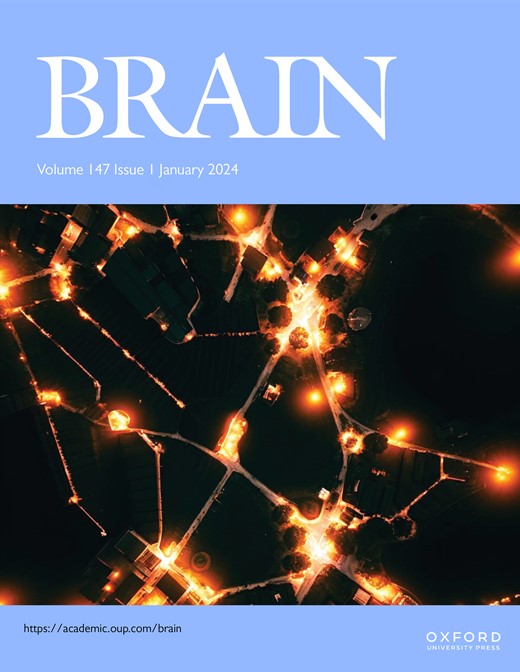Neuronal activity and amyloid-β promote tau seeding in the entorhinal cortex in Alzheimer’s disease
IF 11.7
1区 医学
Q1 CLINICAL NEUROLOGY
引用次数: 0
Abstract
The entorhinal cortex is the first region to develop tau pathology in Alzheimer’s disease and primary age-related tauopathy, yet the reasons for this selective vulnerability remain unclear. We developed a computational model in which neuronal activity and amyloid-β (Aβ) modulate tau transport, hypothesizing that this mechanism explains entorhinal vulnerability to early tau pathology. The model combines structural connectivity with either neuronal activity (measured by heading hierarchy okayfluorodeoxyglucose, FDG PET) or amyloid-β burden (measured by Aβ PET). We analyzed Alzheimer’s Disease Neuroimaging Initiative (ADNI) data comprising 527 FDG PET scans (mean age 71.8 years; 174 cognitively normal, 293 mild cognitive impairment, 60 Alzheimer’s disease) and 1,244 Aβ PET scans (mean age 72.4 years; 501 cognitively normal, 588 mild cognitive impairment, 155 Alzheimer’s disease). From these, 253 FDG–tau and 453 Aβ–tau PET pairs were used in regression analyses. Key results were replicated in the Harvard Aging Brain Study (HABS; 300 FDG, 348 Aβ, 116 FDG–tau, and 255 Aβ–tau pairs). Both FDG- and Aβ-based models consistently identified the entorhinal cortex as a primary tau seeding region in ADNI (FDG: z ≈ 4.6–4.9, p < 0.0066; Aβ: z ≈ 4.0–8.7, p ≤ 0.011) and in HABS (FDG: z = 5.7, p = 0.030; Aβ: z = 6.0, p = 0.0018). Simple linear regression showed modest associations between model-derived seeding and empirical entorhinal tau in ADNI (FDG: β = 6.7, p = 0.0039; Aβ: β = 11.3, p < 0.001), which remained significant after adjustment for age, sex, and APOE4 status (FDG: β = 7.1, p < 0.001; Aβ: β = 9.7, p < 0.001). Aβ-based associations replicated in HABS (β = 3.3, p < 0.001), while FDG-based correlations were not detectable in this predominantly cognitively normal cohort (β = −0.43, p = 0.80; power = 49%). These findings support a mechanistic role for neuronal activity and amyloid-β in initiating tau pathology, with the entorhinal cortex consistently emerging as highly vulnerable. Our computational model reliably identifies this region as the epicenter of pathology, supporting the idea that brain-wide patterns of neuronal activity and amyloid burden determine where tau pathology begins.阿尔茨海默病中神经元活动和淀粉样蛋白-β促进tau蛋白在内嗅皮层的播种
内嗅皮层是阿尔茨海默病和原发性年龄相关的tau病变中第一个发生tau病理的区域,但这种选择性易感性的原因尚不清楚。我们开发了一个计算模型,其中神经元活性和淀粉样蛋白-β (a β)调节tau转运,假设这一机制解释了早期tau病理的内嗅易感性。该模型将结构连通性与神经元活性(通过标题层级测量,氟脱氧葡萄糖,FDG PET)或淀粉样蛋白-β负荷(通过Aβ PET测量)相结合。我们分析了阿尔茨海默病神经影像学计划(ADNI)的数据,包括527张FDG PET扫描(平均年龄71.8岁,174张认知正常,293张轻度认知障碍,60张阿尔茨海默病)和1244张Aβ PET扫描(平均年龄72.4岁,501张认知正常,588张轻度认知障碍,155张阿尔茨海默病)。其中,253对FDG-tau和453对a - β - tau PET进行回归分析。关键结果在哈佛衰老脑研究中得到了重复(HABS; 300个FDG, 348个Aβ, 116个FDG - tau和255个Aβ - tau对)。在ADNI (FDG: z≈4.6-4.9,p < 0.0066; a β: z≈4.0-8.7,p≤0.011)和HABS (FDG: z = 5.7, p = 0.030; a β: z = 6.0, p = 0.0018)中,FDG-和a β: z = 6.0, p = 0.0018)均一致认为内嗅皮层是主要的tau种子区。简单线性回归显示,模型衍生的播种与ADNI的经验内鼻tau之间存在适度关联(FDG: β = 6.7, p = 0.0039; Aβ: β = 11.3, p < 0.001),在调整年龄、性别和APOE4状态后,这种关联仍然显著(FDG: β = 7.1, p < 0.001; Aβ: β = 9.7, p < 0.001)。基于a β的相关性在HABS中也存在(β = 3.3, p < 0.001),而基于fdg的相关性在这个主要认知正常的队列中未被检测到(β = - 0.43, p = 0.80,功率= 49%)。这些发现支持神经元活动和淀粉样蛋白β在启动tau病理中的机制作用,内嗅皮层始终表现出高度脆弱。我们的计算模型可靠地将该区域确定为病理中心,支持全脑神经元活动模式和淀粉样蛋白负担决定tau病理开始的观点。
本文章由计算机程序翻译,如有差异,请以英文原文为准。
求助全文
约1分钟内获得全文
求助全文
来源期刊

Brain
医学-临床神经学
CiteScore
20.30
自引率
4.10%
发文量
458
审稿时长
3-6 weeks
期刊介绍:
Brain, a journal focused on clinical neurology and translational neuroscience, has been publishing landmark papers since 1878. The journal aims to expand its scope by including studies that shed light on disease mechanisms and conducting innovative clinical trials for brain disorders. With a wide range of topics covered, the Editorial Board represents the international readership and diverse coverage of the journal. Accepted articles are promptly posted online, typically within a few weeks of acceptance. As of 2022, Brain holds an impressive impact factor of 14.5, according to the Journal Citation Reports.
 求助内容:
求助内容: 应助结果提醒方式:
应助结果提醒方式:


